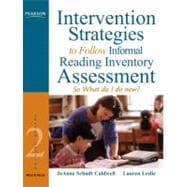
Joanne Schudt Caldwell is the co-author/author of seven titles includingThe Qualitative Reading Inventory-4 and Reading problems: Assessment and Teaching Strategies both published by Allyn & Bacon. She received her Ph.D. in Educational Psychology from Marquette University and currently teaches Literacy and Language Development at Cardinal Stritch University. In 1996 she received the Outstanding Service Award from the Wisconsin State Reading Association, as well as the Wisconsin Teacher Educator of the Year Award in 1997 and the Achievement Award from Marquette University School of Education in 2005.
Lauren Leslie received her Ph.D. in Educational Psychology from the University of Iowa and is currently Emeritus Professor at Marquette University where she served as the director of the Hartman Literacy Center for many years. She has published over 25 research articles, and she is the co-author of the Qualitative Reading Inventory-4. She received the Albert J. Harris Award from International Reading Association (2001) for article written with L. Allen, “ Factors that predict success in an early literacy intervention program.” She also received the Mary Neville Bielefeld Award for Career Achievement for her contributions to teaching, research and service, particularly the mentoring of women faculty and students.
| Preface | p. ix |
| An Overview of Reading Instruction for Struggling Readers | p. 1 |
| Reading Instructionndash;Past Perspectives | p. 1 |
| Reading Instructionndash;Present Perspectives | p. 3 |
| Principles of Effective Intervention Programs | p. 4 |
| Current Issues | p. 5 |
| Summary | p. 9 |
| References and Recommended Readings | p. 10 |
| Patterns of Reading Difficulty | p. 15 |
| General Patterns | p. 15 |
| Defining a Studentrsquo;s Reading Level | p. 17 |
| Reading Level: An Indicator of Problem Severity | p. 18 |
| Reading Level: An Indicator of Word Identification Proficiency | p. 18 |
| Reading Level: An Indicator of Comprehension Proficiency | p. 21 |
| Designing the Intervention Focus | p. 22 |
| Summary | p. 23 |
| References and Recommended Readings | p. 24 |
| The Structure of Intervention Sessions | p. 25 |
| The Importance of Consistent Structure | p. 26 |
| Individual Tutoring Structures at the Elementary Level | p. 28 |
| Individual Tutoring Structures at the Middle Level | p. 29 |
| Group Tutoring Structures at the Elementary Level | p. 29 |
| Group Tutoring Structures at the Middle Level | p. 32 |
| Group Tutoring Structures at the High School Level | p. 33 |
| Classroom Intervention Structures | p. 34 |
| Schoolwide Intervention | p. 36 |
| Designing Your Own Structure | p. 36 |
| Application to English Language Learners | p. 37 |
| Application to Adolescent Learners | p. 41 |
| Response to Intervention | p. 41 |
| Summary | p. 41 |
| References and Recommended Readings | p. 42 |
| Phonological Awareness | p. 45 |
| What Is Phonological Awareness and Why Is It Important? | p. 46 |
| The Importance of Rhyme | p. 48 |
| The Informal Reading Inventory as an Indicator of Rhyme Knowledge | p. 49 |
| Phonological Awareness Instruction | p. 50 |
| The Importance of Phonemic Awareness | p. 53 |
| Developing Phonemic Awareness Aurally | p. 55 |
| Application to English Language Learners | p. 58 |
| Application to Adolescent Learners | p. 60 |
| Response to Intervention | p. 60 |
| Summary | p. 61 |
| References and Recommended Readings | p. 61 |
| Word Identification Instruction: Phonics and More | p. 63 |
| What is Systematic Phonics Instruction? | p. 64 |
| The Informal Reading Inventory as an Indicator of Problems with Word Identification | p. 65 |
| Guidelines for Exemplary Phonics Instruction | p. 67 |
| Teaching Consonant Sounds Using Shared Reading | p. 69 |
| Teaching Vowel Sounds: Using Spelling Patterns to Read by Analogy | p. 72 |
| The Importance of Cross-Checking | p. 76 |
| How to Learn Words That Are Difficult to Decode | p. 81 |
| Putting It All Together: Guided Reading | p. 85 |
| Teacher Prompting During Oral Reading | p. 87 |
| Application to English Language Learners | p. 88 |
| Ap | |
| Table of Contents provided by Publisher. All Rights Reserved. |
The New copy of this book will include any supplemental materials advertised. Please check the title of the book to determine if it should include any access cards, study guides, lab manuals, CDs, etc.
The Used, Rental and eBook copies of this book are not guaranteed to include any supplemental materials. Typically, only the book itself is included. This is true even if the title states it includes any access cards, study guides, lab manuals, CDs, etc.